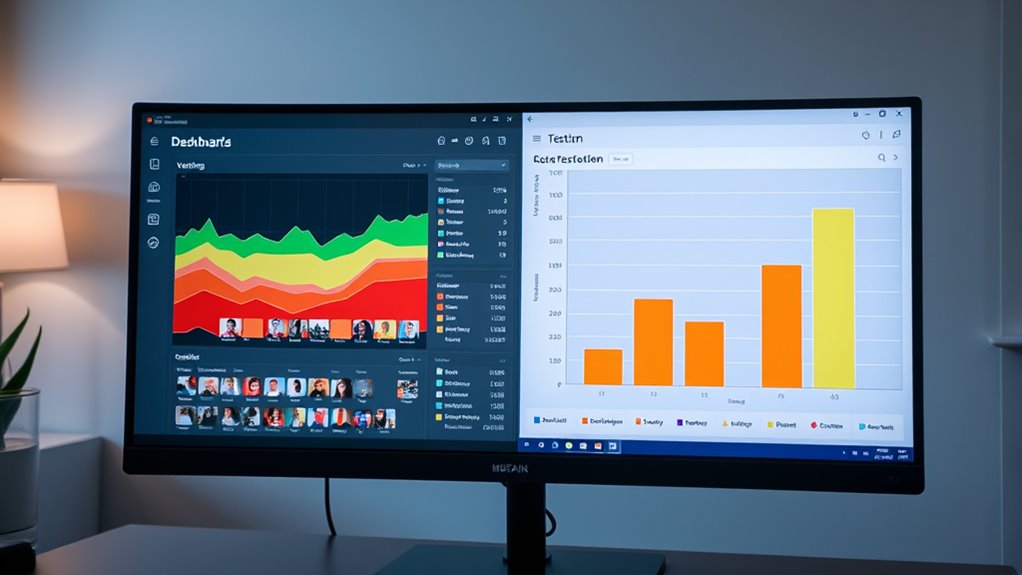When choosing between multivariate testing and A/B testing, consider your goals and resources. Use A/B testing for quick, simple improvements on one element, especially if you have limited traffic or need fast results. Opt for multivariate testing when you want to analyze multiple variables at once and gain deeper insights into how combined elements influence user behavior. If you want to explore both approaches further, you’re in the right place to find out more.
Key Takeaways
- Use A/B testing for quick, simple improvements when resources and traffic are limited.
- Opt for multivariate testing when analyzing multiple elements and interactions for comprehensive insights.
- Choose A/B testing for focused experiments with smaller sample sizes and faster results.
- Select multivariate testing to optimize complex pages with many variables and higher traffic capacity.
- Combine both methods strategically for optimized, data-driven decision-making across your website or campaigns.

When it comes to optimizing your website or marketing campaigns, understanding the difference between multivariate testing and A/B testing is essential. Both methods help you make data-driven decisions, but they serve different purposes and are suited for different scenarios. Your goal is to improve user experience and increase conversions, and choosing the right approach depends on your specific needs and resources.
Understanding A/B and multivariate testing helps optimize user experience and conversions effectively.
A/B testing is straightforward: you compare two versions of a single element, like a headline or a call-to-action button, to see which performs better. It’s simple to set up, and you don’t need a lot of traffic to get meaningful results. This approach is ideal when you want to test one variable at a time, making it easier to analyze the data and interpret the impact on user experience. Because you’re focusing on one change, the data analysis is clearer, and you can confidently attribute improvements to that specific adjustment. It’s perfect for quick experiments and when your goal is to optimize a single aspect of your website or campaign.
In contrast, multivariate testing involves experimenting with multiple variables simultaneously. You create different combinations of elements, such as headlines, images, and colors, and see how these combinations influence user behavior. This method provides a richer dataset, revealing how different factors interact and contribute to overall performance. However, because multiple variables change at once, data analysis becomes more complex. You need larger sample sizes and more sophisticated tools to interpret the results accurately. Multivariate testing is particularly useful when you want to optimize several elements at once and understand how they work together to enhance user experience.
Choosing between the two depends on your objectives and resources. If you’re looking to make quick, simple improvements, A/B testing is your best bet. It’s less resource-intensive and offers clear insights with minimal complexity. But if you’re aiming for a detailed optimization of multiple elements and have enough traffic to support thorough analysis, multivariate testing can provide deeper insights. Keep in mind that multivariate testing requires more planning, time, and data analysis expertise.
Ultimately, both testing methods are valuable tools in your optimization toolkit. Use A/B testing for quick wins and straightforward changes, and turn to multivariate testing when you need a holistic view of how various elements work together to improve user experience and boost performance. By understanding the strengths and limitations of each, you can make smarter decisions and enhance your website’s effectiveness. Additionally, leveraging content personalization can further improve your testing outcomes by tailoring experiences to specific audience segments.
Frequently Asked Questions
How Do I Determine Which Testing Method Suits My Business Size?
You should choose your testing method based on your business scale and testing complexity. If you’re a small business with limited resources, A/B testing is simpler and faster, helping you make quick decisions. For larger businesses with more traffic and multiple variables, multivariate testing allows you to analyze several elements simultaneously, providing deeper insights. Assess your resources and goals to select the approach that best aligns with your testing needs.
What Are the Costs Involved in Multivariate Vs A/B Testing?
Did you know multivariate testing can cost up to three times more than A/B testing? Testing expenses for multivariate testing are higher because it requires more variations and data analysis to interpret results accurately. A/B testing is simpler and cheaper, making it ideal for smaller budgets. You should consider your goals and budget to choose the right approach, ensuring your testing expenses align with your resources and expected insights.
Can I Combine Both Testing Approaches for Better Insights?
Yes, you can combine both testing approaches for better insights by integrating tests and analyzing data together. Test integration allows you to run multivariate and A/B tests simultaneously, saving time and resources. During data analysis, you can compare results to identify which elements or combinations perform best. This combined approach offers an all-encompassing understanding of user preferences, enabling you to optimize your strategies effectively.
How Do I Interpret Conflicting Results From Different Tests?
When you encounter test result discrepancies, don’t panic. Instead, analyze the conflicting data carefully, considering sample sizes, test duration, and external factors. Look for patterns or consistent trends across tests, and prioritize the most reliable data. Remember, conflicting results often highlight the need for further testing or deeper insights. Use a systematic approach to interpret these conflicts, refining your hypotheses for better decision-making.
What Are Common Pitfalls to Avoid in Each Testing Method?
Think of testing as steering a river—avoid testing biases that steer you off course and make certain your sample size is large enough to trust your findings. In each method, rushing can cause shallow results—so, don’t overlook the importance of proper randomization and control variables. Stay vigilant for false positives and make sure your data truly reflects real user behavior, keeping your testing journey steady and reliable.
Conclusion
Understanding when to use multivariate testing versus A/B testing can considerably boost your results. Did you know that companies using multivariate testing see a 20% increase in conversion rates compared to those relying solely on A/B tests? By choosing the right approach—A/B for simple comparisons or multivariate for complex variables—you optimize your website’s performance. So, analyze your goals carefully, and leverage the most effective testing method to maximize your success.








